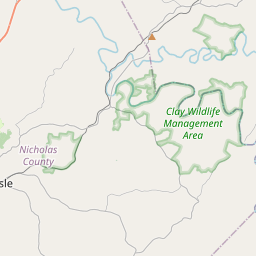Ringos Mill Covered Bridge







This bridge and the surrounding community developed because of a grist mill operating on Fox Creek in the mid-1800s. The single span structure is 86 ft. long and built, 1867, on popular Burr truss design. The original yellow pine trusses remain. Abutments are of "red stone" covered with a concrete facing. Listed on the National Register of Historic Places, 1976.
(Reverse) Covered Bridges - Covered bridges were first built in the 1790s but did not become widely popular until after 1814. They were covered to protect them from the weather. At one time there were more than 400 covered bridges in Ky. The timbered spans have played a romantic role in our history. Some were destroyed during the Civil War. The remaining ones are a nostalgic link with the past
More history nearby
In 1937, the town of Maysville, Kentucky, became the site of the first public works project built under President Franklin D. Roosevelt's New Deal program.
European settlers began arriving in the late 18th century, with the establishment of the first settlement known as Fleming Station in 1782. The county grew rapidly, and in 1798, it was officially established as Fleming County, incorporating several smaller settlements. The county seat was established in Flemingsburg, named after Colonel Fleming, and it remains the center of government and commerce to this day.
During the Civil War, Fleming County was deeply divided, with residents on both sides of the conflict. The county saw many skirmishes and several notable battles, such as the Battle of Flemingsburg in 1862. After the war, the county experienced a period of recovery and development, particularly in agriculture, with tobacco being a major cash crop.
In the 20th century, Fleming County faced various challenges and changes. The decline of tobacco farming and the rise of industrialization led to shifts in the local economy. Today, Fleming County is known for its beautiful rolling hills, rich farmland, and close-knit community. It continues to preserve its historical landmarks and embrace its Appalachian heritage, while evolving to meet the needs of its residents in the modern era.
Fleming County Timeline
This timeline provides a glimpse into the major events and milestones that have shaped the history of Fleming County, Kentucky.
- 1798 - Fleming County is established as one of the original nine counties of the Kentucky State.
- 1816 - The town of Flemingsburg, the county seat of Fleming County, is founded.
- 1861-1865 - Fleming County, like many other regions in Kentucky, is deeply divided during the American Civil War.
- 1892 - The Fleming County Courthouse, a landmark in Flemingsburg, is built.
- 1923 - Blue Licks Battlefield State Resort Park is established to commemorate the Battle of Blue Licks, which took place in Fleming County during the Revolutionary War.
- 1964 - The Daniel Boone National Forest is established, which includes parts of Fleming County.
- 1974 - The Fleming County Covered Bridge, a historic landmark, is listed on the National Register of Historic Places.
- 2006 - The Fleming County Covered Bridge is destroyed by a flood.